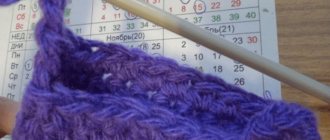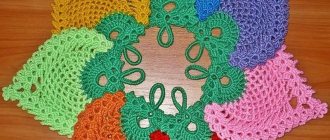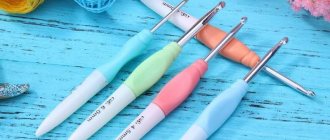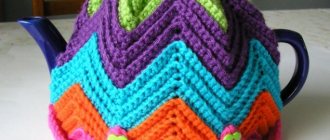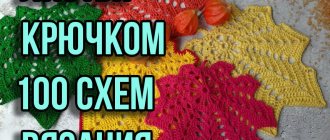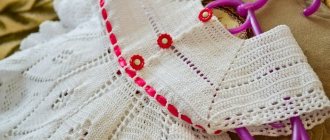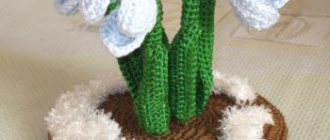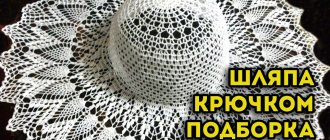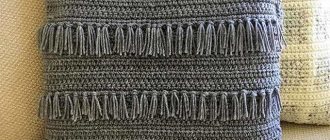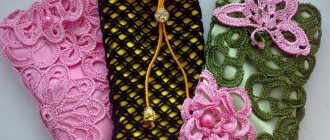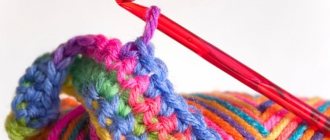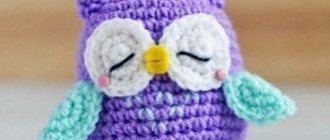Traditionally, everyone gives each other gifts on Easter. I suggest making them yourself. Knitted eggs can be used to decorate the interior of your home for the holiday, make a composition out of them, or put them in a basket or vase. Such a gift will definitely be remembered and appreciated. Based on a knitted egg, you can knit other quite interesting gifts.
Notations used in the article:
RLS - single crochet,
VP - air loop,
СС - connecting post,
PR = increase - knit 2 sc in one loop,
UB = decrease - instead of two sc, you need to knit 1 sc. (You can simply skip one sc of the previous row and knit in the next one, then a hole will form.) I found a way to knit decreases so that they are not noticeable. I am sharing with you.
Chickens.
These wonderful chicks are knitted from white acrylic (50 g 133 m), the remnants of yellow grass-stretch yarn from Kamtex, hooks No. 2 and No. 3. You will also need: filler, 2 beads with a diameter of 6 mm or black threads for the eyes, red floss threads for the beak.
We knit the same way as an egg (see text above) with yellow yarn with pile. As you knit, if it suddenly seems that the chicken is fluffier on the wrong side, you can turn this unknitted egg inside out. Knit eggshells with white thread in the other direction, along the new front side. We knit a white hat on top separately (just like the place where it will lie). It will be held in a bow on the top of the head. We pierce the top of the head with a needle and thread, make one stitch, and tie the ends of the thread with a bow.
How to knit a chicken beak.
Take red floss and hook No. 2. We collect 6 sc in the amigurumi ring. SS close them in a circle.
1 row. *PR, 2 RLS* 2 times. Total 8 sc.
2nd row. *PR, 3 RLS* 2 times. Total 10 sc.
Sew the beak to the body. Sew button eyes or embroider eyes with black thread.
The chicken is ready!
Decorative Easter napkin
Have you ever met such a beauty? Again, everything is quite simple!
I don’t know how to knit the ducks next to the photo. But there is a description of similar and even better baskets with bunnies.
So, for the napkin, first we knit a circle with double crochets.
Separately, we make an openwork border and sew it to the round blank at some distance from the edge.
Now the edges of the frill need to be folded and attached to the base of the circle using knitted flowers.
Decorative or boiled colored eggs can be placed in the resulting pockets.
Gift for Easter. Hen.
To crochet an Easter chicken we will need:
- a little acrylic or woolen yarn of white or beige color (I used Schachenmayr Idena Plus yarn, 100% acrylic, 50 g. = 133 m.); - some brown yarn (for the nest) (I used the remains of Gjestal Superwash Sport yarn, 100% wool, 50 g = 100 m.) - the remains of red and yellow yarn (I used for the comb - Schachenmayr Idena Plus, 100% acrylic , 50 g = 133 m, for the beak - “Lotus” from the Kamtex factory, 100% acrylic, 50 g = 150 m in 2 threads); - hook No. 4; — filler (sintepon is best); - cardboard for the base of the nest (you don’t have to use it); - black threads.
Knitting description:
Chicken body:
Row 1: cast on 2 ch. and close it in a ring. Knit 6 tbsp. b/n. [= 6 tbsp. b/n]. Next knit in the round;
2nd row: *increase*. Repeat * 6 times [= 12 tbsp. b/n].
3rd row: * increase, 1 tbsp. b/n *. Repeat * 6 times [= 18 tbsp. b/n].
4th row: knit the entire row of st. b/n [= 18 tbsp. b/n];
Row 5: * increase, 2 tbsp. b/n *. Repeat * 6 times [= 24 tbsp. b/n].
Rows 6-7 (2 rows): knit st. b/n [= 24 tbsp. b/n];
Row 8: * increase, 3 tbsp. b/n*. Repeat * 6 times [= 30 tbsp. b/n].
Rows 9-11 (3 rows): knit st. b/n [= 30 tbsp. b/n];
Row 12: * increase, 4 tbsp. b/n*. Repeat * 6 times [= 36 tbsp. b/n].
Rows 13-18 (6 rows): knit st. b/n [= 36 tbsp. b/n];
Row 19: * decrease, 4 tbsp. b/n *. Repeat * 6 times [= 30 tbsp. b/n];
Row 20: * decrease, 3 tbsp. b/n *. Repeat * 6 times [= 24 tbsp. b/n];
Row 21: * decrease, 2 tbsp. b/n *. Repeat * 6 times [= 18 tbsp. b/n]. Fill the body with padding polyester;
Row 22: * decrease, 1 tbsp. b/n *. Repeat * 6 times [= 12 tbsp. b/n]; If necessary, add a little more filler.
Rows 23-24: repeat decreases until the hole is completely closed. Break the thread and hide the end inside.
Beak:
Row 1: cast on 2 ch. and close it in a ring. Knit 6 tbsp. b/n. [= 6 tbsp. b/n]. Next knit in the round;
2nd row: *increase, 1 tbsp. b/n *. Repeat * 3 times [= 9 tbsp. b/n].
3rd row: * increase, 2 tbsp. b/n *. Repeat * 3 times [= 12 tbsp. b/n].
4th row: knit the entire row of st. b/n [= 12 tbsp. b/n]. Break the thread
Wings (2 parts):
Row 1: cast on 2 ch. and close it in a ring. Knit 6 tbsp. b/n. [= 6 tbsp. b/n]. Next knit in the round;
2nd row: *increase*. Repeat * 6 times [= 12 tbsp. b/n].
3rd row: * increase, 5 tbsp. b/n *. Repeat * 2 times [= 14 tbsp. b/n].
Rows 4-6 (3 rows): knit st. b/n [= 14 tbsp. b/n];
Row 7 (incomplete): 7 tbsp. b/n, 1 tbsp, break the thread.
Scallop:
1st row (persons): on the top of the chicken, knit 7 tbsp directly along the knitted fabric. b/n. It is best to start with the loops of the 2nd row, and then move through the crown towards the back of the chicken. At the same time, you must try to knit all the stitches in one straight line [= 7 tbsp. b/n]. Turn knitting over;
Row 2 (purl): ch 1 rise, 1 vp, skip 1 tbsp. b/n of the previous row and knit 1 tbsp. b/n, 1 vp, skip 1 tbsp. b/n of the previous row and knit 1 tbsp. b/n. Thus, in the second row we have formed 3 arches (holes). Turn the knitting over.
Row 3 (knit): - ch 2 lifting, 3 tbsp. s/n in the first arch, 2 vp, 1 s. Art. in the first arch (the first petal of the comb) - 1 s. Art. to go to the second arch, 2 ch. lifting, 1 tbsp. s/n, 1 tbsp. with 2n, 1 tbsp. s/n, 2 vp, 1 s. Art. in the second arch (second petal of the comb) - 1 s. Art. to move to the third arch, 2 ch. lifting, 3 tbsp. s/n, 2 vp, 1 s. Art. into the third arch (third petal of the comb) Break the thread and tuck it inside.
The tail is knitted according to the same principle as the comb.
1st row (persons): at the level of the 15-16th row of the body, knit 7 tbsp directly along the knitted fabric. b/n. thread of the same color as the body (try to place the tail strictly in the middle of the back of the chicken) [= 7 tbsp. b/n]. Turn knitting over;
Row 2 (purl): ch 1 rise, 1 vp, skip 1 tbsp. b/n of the previous row and knit 1 tbsp. b/n, 1 vp, skip 1 tbsp. b/n of the previous row and knit 1 tbsp. b/n. Thus, in the second row we have formed 3 arches (holes). Turn the knitting over.
3rd row (knit): - 2 ch. lifting, 3 tbsp. s/n in the first arch, 2 vp, 1 s. Art. in the first arch (first petal of the tail) - 1 s. Art. to go to the second arch, 2 ch. lifting, 1 tbsp. s/n, 2 tbsp. with 2n, 1 tbsp. s/n, 2 vp, 1 s. Art. in the second arch (second petal of the tail) - 1 s. Art. to move to the third arch, 2 ch. lifting, 3 tbsp. s/n, 2 vp, 1 s. Art. into the third arch (third petal of the ponytail) Break the thread and tuck it inside.
Advice:
If you are unable to cast on stitches directly from the knitted fabric or cast on does not form a straight line, you can knit the comb and tail separately and then sew them to the body. To do this, you need to cast on 7 chain stitches in the first row, and then knit according to the description, knitting double stitches of the first row into chain stitches.
Nest.
1 row. Knit 6 tbsp into an amigurumi ring. b/n. [= 6 tbsp. b/n]. Next knit in the round;
2nd row: *increase*. Repeat * 6 times [= 12 tbsp. b/n].
3rd row: * increase, 1 tbsp. b/n *. Repeat * 6 times [= 18 tbsp. b/n].
4th row: * increase, 2 tbsp. b/n *. Repeat * 6 times [= 24 tbsp. b/n].
Row 5: * increase, 3 tbsp. b/n*. Repeat * 6 times [= 30 tbsp. b/n].
Row 6: * increase, 4 tbsp. b/n*. Repeat * 6 times [= 36 tbsp. b/n].
Row 7: * increase, 5 tbsp. b/n*. Repeat * 6 times [= 42 tbsp. b/n].
Row 8: knit st. s/n, capturing only the back half-loop of the columns of the previous row [= 42 st. b/n].
Note!
When switching to double crochet, the bottom can expand greatly, but later, after 9-11 rows are knitted, it should take the shape of a “cup” with vertical walls. If this does not happen and the bottom is more reminiscent of a flat plate than a glass, I recommend reducing the number of loops in the 8th row, for example, in those places where increases were made in the 7th row, skip 1 stitch of the previous row or, even more preferably, knit 2 stitches together as described above.
Rows 9-11 (3 rows): knit st. s/n [= 42 st. b/n];
Row 12: knit the entire circular row in a crawfish step. Break the thread.
For greater stability, you can place a circle of cardboard at the bottom of the nest, the diameter of which matches the diameter of the bottom.
Tips for making a nest:
I recommend doing the transition from single crochets to double crochets gradually, i.e. in the 8th row knit 1 tbsp. b/n, then 1 half double crochet, and then continue knitting with double crochets, capturing only the back half loop of the previous row. In the next circular row, at the transition point, I also recommend knitting 1 half double crochet, and then continue knitting with double crochets. This will make the transition look smoother and smoother.
If a knitted chicken is an Easter gift,
then it is better to hide the cardboard disk between two knitted layers, in other words, make the bottom double. To do this, you need to knit the inner bottom according to the description of 1-7 rows and break the thread, then knit the outer bottom, also according to the description of 1-7 rows, but do not break the thread.
Next, attach the bottoms with the wrong sides to each other, put a cardboard base between them and knit the 8th row of double crochets, hooking the outer bottom only to the back half-loop, and the inner bottom to both half-loops.
Please note that a double bottom with cardboard inside is higher than a single bottom, so the height of 4 rows of double crochets may not be enough. In this case, knit another circular row with double crochets (i.e. the height of the nest will be 5 rows of double crochets, not 4), and then tie the nest in a crawfish step.
Assembly:
1. Put a little filler into the beak and sew it to the body;
2. Sew on the wings;
3. Design the face;
4. Place the chicken in the nest.
Here's a gift for you for Easter. Knitted Easter chicken is ready!
Easter bunny, gift for Easter.
Author katty toys msk Instagram
EASTER CAKE IN A BASKET
Description of the author. When using Children's New yarn and a 1.75 hook, the size of the cake = 4 cm, the basket is 4.5 cm in diameter. The work took about 2 hours.
Author Svetlana Kholmanskikh Yarn will be needed: - for the Easter cake Alize Cotton Gold - Alize Lana Gold for the basket - for the napkin Alize Bambo Fine or any thin yarn
You can tie an egg. Gift for Easter
Patterns of Easter napkins in the shape of eggs
There are quite a few patterns for knitting mini-napkins, including flowers, various ornaments, chickens, and rabbits. When knitting from iris, some of them can turn out to be approximately 21 x 18 cm in size, but I can’t say more specifically about all of them.
You can start knitting from any edge - narrow or wide, or from the middle in both directions, it doesn’t matter, but I’ve already told you how to make “steps” (increases and decreases) here>>.
In addition to the above option for decorating a fabric napkin, such eggs can be hung on a branch, decorated with them on the edge of a large basket or a small pincushion, or made into an original postcard. In general, find any use other than direct use as coasters for cups and table settings.
I also really like the idea of making an openwork cap for an egg.
You can use not only these two diagrams, which accompany this photo on the networks, but also draw the patterns yourself, and the above drawings can also work, only you will need to cut off the base a little so that the edge of the egg is flat.
Making such a bag is simple: you need to knit two identical parts, connect them, tie them with a simple border (arches), into which you insert a satin ribbon.
Knitted Easter cake. Gift for Easter.
Gift for Easter. Kulich box.
Variations
Crocheting for Easter doesn't have to be boring. Even a simple egg can be turned into a real masterpiece. Create pieces in different colors that coordinate with each other. They can become an indispensable interior decoration for the holiday or a nice gift. Take fancy yarn “grass”, bouclé or a simple one, but with sectional dyeing. By interspersing multi-colored pieces of thread, you will get stripes or spots. Show your imagination and a funny picture will appear on the egg.
Satin ribbons and lace are perfect for decorating the finished work. Rhinestones or a small scattering of beads will add shine and charm. All you have to do is glue on the eyes and embroider the mouth - and this is a character come to life. You can actively involve children in the production and design. They will definitely enjoy working with their mother and feeling involved in the holiday bustle.
Easter gift. Chick.
Author Tatyana Lysenko You will need: 1. Yarn of yellow, white, brown, orange Kamtex lotus stretch 2. Hook No. 2.5 3. Filling 4. Needle, thread, scissors 5. Buttons for decoration, beads or eyes 6. Ribbon for a ponytail
Torso:
1 row. Knit 6 sc into an amigurumi ring, [6 sc in a row] 2nd row. PR, repeat 6 times [12 sc] 3rd row. PR, 1 sc, repeat 6 times [18 sc] 4th row. PR, 2 sc, repeat 6 times [24 sc] 5th row. PR, 3 sbn, repeat 6 times [30 sbn] 6th row. PR, 4 sc, repeat 6 times [36 sc] 7th row. PR, 5 sc, repeat 6 times [42 sc] rows 8-10. 42 sc 11 row. UB, 5 sc, repeat 6 times (36 sc) rows 12-14. 36 sc 15 row. UB, 4 sc, repeat 6 times (30 sc) rows 16-18. 30 sc 19 row. UB, 3 sc, repeat 6 times (24 sc) 20-22 rows. 24 sc 24-25 rows. 18 sc 26 row. UB, 1 sc, repeat 6 times (12 sc) row 27. 6 ST 28 row. close.
Wings. 2 details.
1 row. Knit 6 sc into the amigurumi ring, [6 sc in a row] 2nd row. PR, repeat 6 times [12 sc] 3rd row. PR, 5 sbn, increase, 5 sbn (14 sbn) 4th row. 14 sc 5th row. UB, 5 sbn, decrease, 5 sbn (12 sbn) 6th row. UB, 4 sbn, decrease, 4 sbn (10 sbn) 7th row. UB, 3 sbn, decrease, 3 sbn (8 sbn) 8th row. UB, 2 sbn, decrease, 2 sbn (6 sbn) 9th row. UB, 1 sbn, decrease, 1 sbn (4 sbn) Row 10: 2 decreases, close the row, cut and hide the thread
Eyes. 2 parts
1 row. In the amigurumi ring we will knit 6 sc, [in a row 6 sc] Row 2: increase, repeat 6 times [12 sc] Row 3: increase, 1 sc, repeat 6 times [18 sc] Row 4: increase, 2 sc, repeat 6 times [24 sc] Fingers 8 pcs: 1 row: cast on 2 ch with brown thread. and close it in a ring. Knit 6 sbn, then knit in a circle [6 sbn] 2-6 rows: 6 sbn 7th row: 3 decreases, close the row, hide the thread.
Chicken
It’s simply impossible to imagine Easter souvenirs without these charming representatives of the feathered world. In many homes you can find charming hens that decorate teapots and flower pots. Want to knit it yourself? We have selected the simplest scheme especially for you.
What we need:
- leftover yarn (pink, lemon and red);
- hook No. 3 or No. 5;
- beads.
However, you can choose your own colors, but the presence of red is mandatory - this is the beak and comb of our future chicken.
Knitting instructions:
- Take red yarn and knit 16 sc.
- We change the thread, thus knitting 6 more rows.
- We make an increase in each loop of the bottom row.
- We mark the location of the future ponytail - to do this, you need to fold the knitting in half.
- We turn the chicken with the front part and count the beginning of a new row.
- We continue knitting RLS without knitting 2 loops to the mark (we knit 2 stitches in them, and we knit 2 more stitches after the mark with two stitches for each loop).
- We finish this row with sc.
- Tail: 2 stitches in 4 loops of the bottom row.
- Change the thread, knit one sc in each loop.
- We change the thread again, do not knit 8 loops to the middle of the tail (we knit two double crochets in them before the middle and after).
- Next, one sc to the end of the row.
- Change the thread, knit sc to the tail.
- In the tail we knit all the loops of the dc.
- Change the thread, sc again.
- Again we change the thread and knit a row of sc.
- In the tail there is again a dc (two stitches per loop).
- We finish with a sc (knit like this until the tail).
- Tail: make a yarn over, insert a hook into it and pull out the working thread, knit them. We repeat this three times, after which we knit the elongated loops together.
- We make a VP and knit in this way until the tail reaches the desired size.
- Finishing RLS
- Again we change the color of the thread, and continue knitting RLS until the end of the row;
- Tail: 4 VP and RLS between elements;
- Head: attach the red thread.
- We knit a comb (3 VP, 1 sc across both sides of the head along the contour). We knit two rows in this way.
- We attach the red thread to the place of the future beak, make three VPs.
- We knit the place where the thread is attached with a connecting post.
- If desired, sew on beads and you’re done.
Don’t be alarmed, despite the long instructions, the knitting process itself is very simple - you will be able to knit a beautiful chicken the first time.
Assembly of the toy:
We start with the paws: you need to sew the front three fingers and sew the back one to them. The legs are ready, let's sew them to the body.
We make a comb (like a fringe).
Let's sew on the eyes and beak. We sew on the wings last.
The chicken can be tied like this:
And like this:
Easter gift egg stand.
How to knit such a hen-egg stand?
See the article
Crochet Easter chicken. Description, photo.
Easter bunny egg stand.
How to crochet it, see the article Easter chicken and crochet rabbit. Description, photo.
Video tutorials on crocheting toys and decorations for Easter
Easter bunny, souvenir for Easter!
The size of the toy is 15 cm in height.
In the master class I used the following materials:
- Nako Paris yarn white, color No. 300, fluffy (100g/245m, 60% polyamide, 40% acrylic);
- yarn Pekhorka Mongolian camel, color natural gray (100g/300m, wool 50%, acrylic 50%);
- yarn Yarn Art Jeans color blue (50g/160m, polyacrylic - 45%, cotton - 55%);
- hooks No. 3, No. 2 and 2.5;
- plastic spout
- 2 buttons
- bead eyes
- filler.
The video should load here, please wait or refresh the page.
Part 2
The video should load here, please wait or refresh the page.
Ideas from the Internet without description.
How to knit toys in articles:
Crochet toys and knitting toys. Description, photo.
Crochet flowers large and small.
Crochet heart. Schemes, description.
Hearts crocheted and knitted. Present.
Crochet basket. Description, video master class
Crochet goldfish toys
Learning to crochet. For beginners.
Crochet toys in 2-3 hours. For beginners
Toy cat. Knitting. Details.
Crochet bunny toy. Description for beginners.
Findus. Findus cat knitted with knitting needles.
We create the New Year with our own hands.
Crochet Easter chicken and bunny. Description, photo.
Owl crocheted and knitted. Description and diagram.
Crochet butterflies. Schemes, description, video MK.
Crochet and knitting mice. Description and diagrams.
